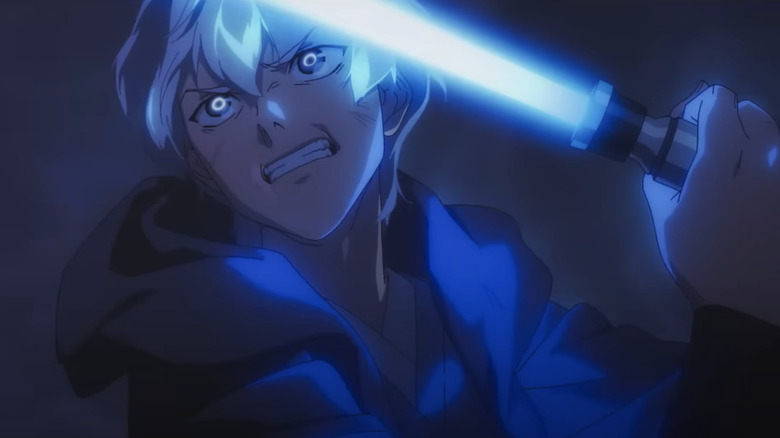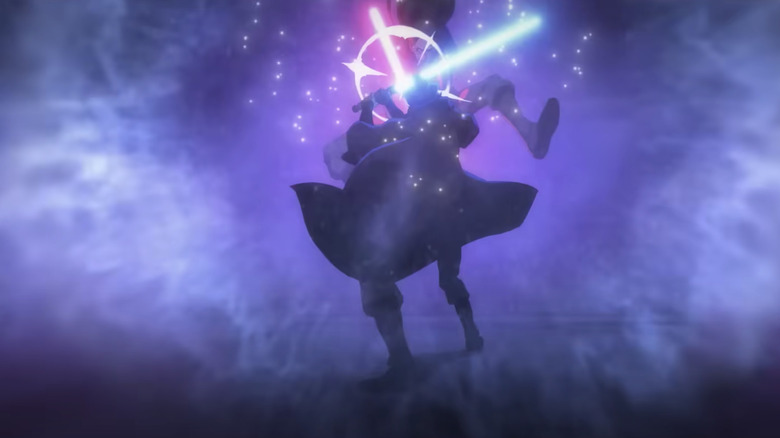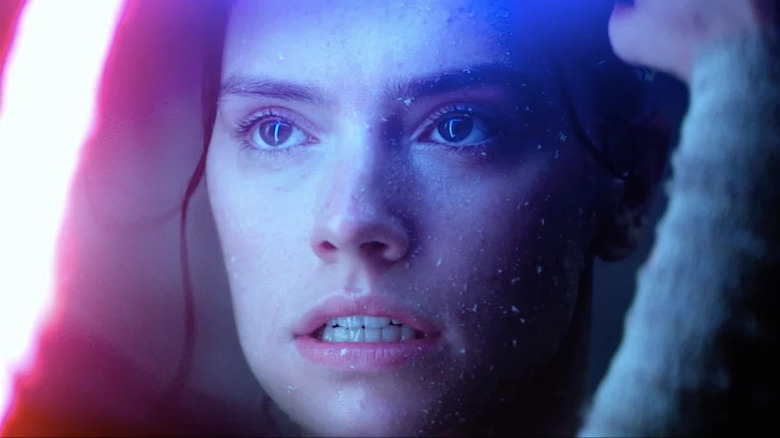Star Wars: Visions Season 2 Has One Of The Best Lightsaber Duels In The Saga
This post contains spoilers for "Star Wars: Visions" season 2.
The highlight of "Star Wars: Visions" season 2 was, for me, episode 5: "Journey to the Dark Head." Animated by South Korea's Studio Mir (which was responsible for the majority of episodes in "The Legend of Korra"), the short is set during a period of open war between the Jedi and the Sith. "Journey to the Dark Head" has the classical anime style that made "The Village Bride" (courtesy of Kinema Citrus) and "The Ninth Jedi" (the work of Production I.G.) such standouts of "Visions" season 1.
There are three main characters. One is Ara (Jang Ye Na/Ashley Park), a young girl born on the Outer Rim planet Dolgarak. On Ara's home is two large parallel statues, representing the light and dark side of the Force. Children are taught to read prophetic images left on the stones below these statues by rain. Ara believes cutting off the head of the dark statue will hurt the Sith, so the young Jedi Toul (Lee Kyung Tae/Eugene Lee Yang) is assigned to go to Dolgarak with her. Toul saw his master struck down by the Sith Lord Bichan (Yun Yong Sik/Daniel Dae Kim), who wants to convert Toul to the dark side and follows the pair to Dolgarak.
This culminates in a fantastic battle between Toul and Bichan across a stone ring surrounding the statue heads. This duel combines the strengths of different lightsaber duels from across the saga, reminding viewers just how awe-inspiring such scenes can be.
Duel choreography besting the prequels
"Journey to the Dark Head" reminded me of the Samurai anime film "Sword of the Stranger." Animated by Studio Bones, that film has an unforgettable finale where a samurai and Chinese warrior engage in an acrobatic swordfight across an emptied fortress.
Toul and Bichan are always moving: their fight takes them from a moving speeder to the statue ring's exterior to its cavernous inside. The scene cuts quickly between wide shots of the two clashing and close-ups to emphasize their battlefield emotions. The "Star Wars" prequels had this sort of duel choreography too; characters would twirl around with their lightsaber swings and make inhuman leaps. However, the actors also moved with a slight sluggishness, which underlined how their movements were pre-choreographed.
In live-action, this results in flashy but inauthentic duels. In animation, though, it's exhilarating. It's easier to buy impossible movements when the duelists aren't real to begin with. Animated characters can also move at the exact speed and manner an artist deems so, without an actor having to worry about timing or following steps. Instead of lightly parrying, Toul and Bichan slam into each other, their blades crackling with power and their brows sweaty with determination. This means their duel doesn't feel weightless like the battles in the prequels often did.
Speaking of which; the duel ends when Bichan holds the disarmed Toul over the ring's edge. Ara, recognizing the scene as one from an earlier vision, detonates the bombs she brought to destroy the statue in the ring's empty center instead. This distracts the Sith lord long enough for Toul to leap toward him and deal a decapitating strike. This concluding chain of events recalls how Obi-Wan defeats Darth Maul in "The Phantom Menace" — a Jedi leaps, pulls a lightsaber to them with the Force, then strikes down the Sith.
Using Lightsabers for lighting
One of the best things about the lightsaber duels in the "Star Wars" sequel trilogy was their rich colors — props to both Dan Mindel (who shot "The Force Awakens" and "The Rise of Skywalker") and Steve Yedlin (who shot "The Last Jedi.") In particular, the scarlet throne room duel in "The Last Jedi," where Rey (Daisy Ridley) and Kylo Ren (Adam Driver) kill Praetorian Guards, has atmosphere to rival the climactic duels of "The Empire Strikes Back" and "Revenge of the Sith."
"Journey to the Dark Head" knows how to use colors too, particularly blue and red. The battle takes place on a cloudy night, so the backgrounds are mostly a purplish-black. That means lightsabers themselves are the primary illumination, which does wonders for the short's mood.
There are a couple of different close-ups of both Bichan and Toul, with their blades interlocked in an X-shape. Each time, Toul's face is mostly blue and Bichan's mostly red, but the colors are mixing. This reflects Toul being pulled toward the dark side as Bichan draws out his rage. These shots also recall the ending of "The Force Awakens," when Rey and Kylo Ren's faces were lit by their sabers in the same way. Blue and red lights run through the statues' ring too — when Ara sees both colors in both statues' heads, she finally realizes that the light can't exist without the dark.
The point of "Star Wars: Visions" is to see the galaxy far, far away rendered through different eyes. It's thrilling when those eyes are as skilled as director Hyeong Geun Park and his colleagues' at Studio Mir.
"Star Wars: Visions" seasons 1 and 2 are streaming on Disney+.


